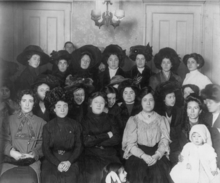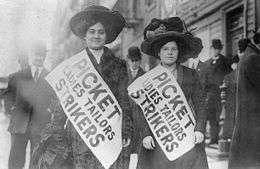New York shirtwaist strike of 1909
|
Two women strikers picketing during the shirtwaist strike of 1909 | |
| Date | November 1909 to March 1911 |
|---|---|
| Location | New York City |
| Also known as | Uprising of the 20,000 |
| Outcome | Successful renegotiation of garment worker contracts |
The New York shirtwaist strike of 1909, also known as the Uprising of the 20,000, was a labor strike primarily involving Jewish women working in New York shirtwaist factories. Led by Clara Lemlich and supported by the National Women's Trade Union League of America (NWTUL), the strike began in November 1909. In February 1910, the NWTUL settled with the factory owners, gaining improved wages, working conditions, and hours. The end of the strike was followed only a year later by the Triangle Shirtwaist Factory Fire, which exposed the plight of immigrant women working in dangerous and difficult conditions.
Background
The population of New York City was more than half immigrant in the early 1900s, many of the shirtwaist workers were immigrants. These immigrants came from a wide variety of backgrounds (such as Jews and Italian), and crowded into immigrant neighborhoods like the Lower East Side of Manhattan Island, which at the time had one of the highest population densities in the world. Many of these immigrants, men, women, and children alike, worked for low pay in factories with terrible working conditions to help support themselves and their families. But they were also exposed to a bustling new world, and to the political and union organizers therein. Immigrant women especially often came from conservative social backgrounds which limited their interaction with men and people outside the family. But New York in the early 1900s provided the opportunity for these women to explore such social interactions, and exhibit a new level of independence.[1]
Many of these women immigrants toiled in the garment industry, which was New York's best known industry at the time.[1] They worked not for a single, large conglomerate but many smaller companies spread across lower Manhattan, among the largest of which were the Triangle and Leiserson shirtwaist factories.[1][2] This workforce was more than 70% women, about half of whom were not yet twenty years old, and about half of whom were Jewish and a third Italian.[1] In the production of shirtwaists in particular, the workforce was nearly all Jewish women. Some of them had belonged to labor unions in Europe before their immigration; many of the Jewish women in particular had been members of the Bund. Thus, they were no strangers to organized labor or to its tactics. Indeed, Jewish women who worked in the garment industry were among the most vocal and active supporters of women's suffrage in New York.[2]
Garment industry workers often worked in small sweatshops, with the men doing the higher-paid work of cutting and pressing while women were paid less for assembling and finishing garments.[1] Work weeks of 65 hours were normal, and in season they might expand to as many as 75 hours. Despite their meager wages, workers were often required to supply their own basic materials, including needles, thread, and sewing machines. Workers could be fined for being late for work or for damaging a garment they were working on. At some worksites, such as the Triangle Shirtwaist Company, steel doors were used to lock in workers so as to prevent workers from taking breaks, and as a result women had to ask permission from supervisors to use the restroom.[2]
Strike

On November 22, 1909, Clara Lemlich had been listening to men speak about the disadvantages and cautions about the shirtwaist workers going on a general strike. After listening to these men speak for four or more hours at a local 25 union meeting, she rose and declared in Yiddish that she wanted to say a few words of her own. After rising to the podium, she declared that the shirtwaist workers would go on a general strike. Her declaration received a standing ovation and the audience went wild. Clara then took an oath swearing that if she became a traitor to the cause she now voted for, then that the hand she now held high wither from her arm. On the 24th of November, less than one day after the strike had been declared, 15,000 shirtwaist workers walked out of the factories, with more joining the strike the following day. The strike lasted until February 1910 and ended in a "Protocol of peace" which allowed the strikers to go back to work and met the demands of the workers, which included better pay, shorter hours, and equal treatment of workers who were in the union and workers who were not.
Legacy
The successful strike marked an important milestone for the American labor movement, and especially for garment industry unions. In addition, Clara Lemlich became a minor star; three novels published soon after the strike had protagonists with her name.[2]
Footnotes
- 1 2 3 4 5 Friedheim, William. "Heaven Will Protect the Working Girl: Viewer's Guide to the 30 Minute Documentary" (PDF). American Social History Project. Retrieved 2009-11-01.
- 1 2 3 4 Sachar, Howard M. (1992). "The International Ladies Garment Worker's Union and the Great Revolt of 1909". Modern History. MyJewishLearning.com. Retrieved 2009-11-01.
See also
For more information, read the book Uprising by Margaret Peterson Haddix.
